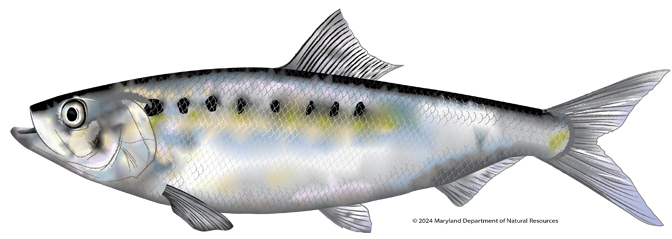| Hickory Shad |
 |
Hickory Shad |
| Alosa mediocris |
(A.K.A. - Hickory Jacks, Tailor Shad)
|
Key Distinguishing Markings:
- The dorsal surface is gray-green in color.
- A dusky shoulder spot may be followed by several faint spots.
- Hickory shad have sharp, saw-like scales or "scutes" along the belly.
- The lower jaw juts out further than the upper jaw, a key identifying feature.
View the Hickory Shad Gallery
|
Distribution:
- Historically, hickory shad spawned in rivers and tributaries along the Atlantic coast from Florida all the way to the Bay of Fundy, Canada.
- Current presence in more northerly waters is uncertain, but recent spawning has been documented as far north as the Connecticut River.
|
Size:
- At 12 to 20 inches, hickory shad are noticeably smaller than American shad but larger than alewife and blueback herring.
|
Habitat:
- The hickory shad, a member of the Clupeidae family, is a schooling species.
- Hickory shad are anadromous fish which spend the majority of their life at sea and only enter freshwater in the spring to spawn.
- Adult hickory shad appear to spawn in a diversity of physical habitats ranging from backwaters and sloughs to tidal and non-tidal freshwater areas of large rivers.
|
Spawning:
- In the Chesapeake Bay, hickory shad spawning runs usually precede American shad runs by beginning in March.
- Peak spawning time is mid-April through late May, with temperatures ranging from 54-72°F. Peak spawning temperature is 59-66°F.
- "Repeat" spawning (spawning several times in a lifetime) in hickory shad runs appears to be common, but tends to vary among river systems. In Maryland, repeat spawning hickory shad account for 30-60% of the migrating adults.
- Spawning hickory shad females (ages 3 to 9) broadcast a large quantity of eggs into the water column which are fertilized by males (ages 2 to 7).
- Fertilized eggs are carried by river currents and hatch within a few days.
- Larvae drift with the current until they mature into juveniles.
- After spawning, adults return to the sea, but their distribution and movements in the ocean are essentially unknown. It is believed that they follow a pattern similar to the coastal migrations of American shad, moving northward after spawning in waters south of and including the mid-Atlantic.
- Increasing water temperatures and photoperiod like influence mature hickory shad migration back to freshwater in the late winter.
|
Fishing Tips:
- A statewide moratorium on the harvest of hickory shad in Maryland waters was implemented in 1980 in order to aid State and coast-wide recovery efforts.
- A catch and release recreational fishery is permitted in Maryland.
- Over the last several years, there has been an increase in hickory shad catches-by both fly and spin fishers in Maryland tributaries, particularly in Deer Creek, the Patuxent River, and in the mainstem Susquehanna River below Conowingo Dam.
- Because hickory shad do not feed in freshwater during their spawning run, artificial baits such as shad darts, small spoons or wet flies are used.
- Current management restrictions can be found on our updated commercial and recreational regulation pages.
|
Fun Fact:
- It was once thought that hickory shad were a hybrid between river herring and American shad, but they really are a distinct species.
- Hickory shad have never been as abundant as other alosine species in the Chesapeake Bay, probably because they are near the northern limits of their spawning range.
- The Maryland state record hickory shad was captured in the Susquehanna River in 1972 and weighed 4 pounds.
- In recent studies, the oldest hickory shad in Maryland was nine years old.
- Maryland stocks between 2 and 10 million juvenile hickory shad per year.
- It is thought that hickory shad strike "fishing bait" because they are guarding their spawning area.
|
| Family: Clupeidae |
| Order: Clupeiformes |
| Class: Actinopterygii (ray-finned fishes) |
For more information on hickory shad and their management, please contact Chuck Stence
Illustration by Kevin Ensor,
Maryland Department of Natural Resources,
Fishing and Boating Services
|
